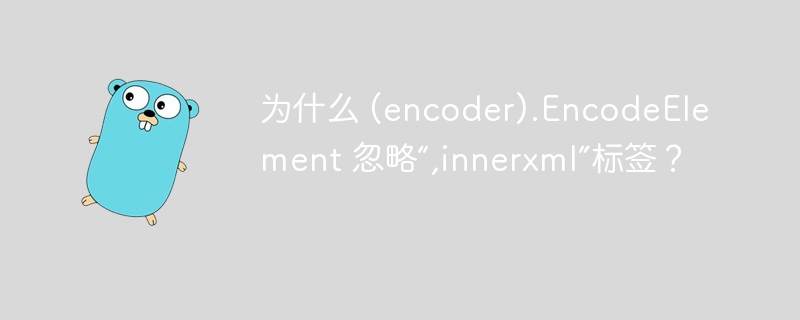為什麼 (encoder).EncodeElement 忽略「,innerxml」標籤?

php小编小新在这里为大家解答一个常见问题:“为什么 (encoder).EncodeElement 忽略“,innerxml”标签?”。这个问题涉及到在使用 (encoder).EncodeElement 方法时,为什么会出现无法编码 innerxml 标签的情况。下面我们将详细回答这个问题,帮助读者更好地理解和解决相关问题。
问题内容
用途:我有一个 xml 文档,其中包含许多混合内容 cdata 元素,我需要以编程方式编辑这些元素。令人烦恼的是,由于 cdata 元素具有其他/混合内容,默认的“,cdata”标记无法正常工作(根据 xml 规范)。如果您对此具体细节有疑问,请告诉我。
问题:在下面的简化示例中,我将其中包含 cdata 的元素标记为“,innerxml”,以便自己处理前缀/后缀。通过解组,一切都按预期工作,但是通过编组(编码),特殊字符被转义。当标签明确表示不转义时(通过“,innerxml”标签),为什么 EncodeElement 方法会转义特殊字符?当我在文档中读到此方法时,它让我参考 xml.Marshal 方法,其中包含以下内容:
<code> a field with tag ",innerxml" is written verbatim, not subject to the usual marshaling procedure. </code>
示例:
以下是代码(也可在 https://go.dev/play/p/MH_ONAVaG_1 获取):
package main
import (
"encoding/xml"
"fmt"
"strings"
)
var xmlFile string = `<?xml version="1.0" encoding="UTF-8"?>
<statusdb>
<status date="today">
<![CDATA[today is < yesterday]]>
</status>
<status date="yesterday">
<![CDATA[PM,
1. there are issues with the marshaller
2. i don't know how to solve them]]>
</status>
</statusdb>`
type statusDB struct {
Status []*status `xml:"status"`
}
type status struct {
Text string `xml:",innerxml"`
Date string `xml:"date,attr"`
}
type statusMarshaller status
func main() {
var projectStatus statusDB
err := xml.Unmarshal([]byte(xmlFile), &projectStatus)
if err != nil {
fmt.Println(err)
return
}
fmt.Println("In Go: \"" + projectStatus.Status[0].Text + "\"")
fmt.Println("In Go: \"" + projectStatus.Status[1].Text + "\"")
x, err := xml.MarshalIndent(projectStatus, "", " ")
if err != nil {
fmt.Println(err)
return
}
//why this is not printing properly
fmt.Printf("%s\n", x)
}
func (tagElement *status) UnmarshalXML(d *xml.Decoder, se xml.StartElement) error {
temp := statusMarshaller{}
d.DecodeElement(&temp, &se)
temp.Text = strings.TrimSpace(temp.Text)
temp.Text = strings.TrimPrefix(temp.Text, "<![CDATA[")
temp.Text = strings.TrimSuffix(temp.Text, "]]>")
*tagElement = status(temp)
return nil
}
func (tagElement status) MarshalXML(d *xml.Encoder, se xml.StartElement) error {
tagElement.Text = "<![CDATA[" + tagElement.Text + "]]>"
temp, _ := xml.Marshal(statusMarshaller(tagElement))
return d.EncodeElement(temp, se)
}此代码返回以下内容:
In Go: "today is < yesterday"
In Go: "PM,
1. there are issues with the marshaller
2. i don't know how to solve them"
<statusDB>
<status><statusMarshaller date="today"><![CDATA[today is < yesterday]]></statusMarshaller></status>
<status><statusMarshaller date="yesterday"><![CDATA[PM,
 1. there are issues with the marshaller
 2. i don't know how to solve them]]></statusMarshaller></status>
</statusDB>
Program exited.结论:有人可以解释一下为什么 xml 包会这样做,以及潜在的解决方法是什么?
谢谢!
解决方法
当然,如果包中的 cdata 允许混合元素,那就太好了,但现在我已经找到了解决方法,即上面的代码,进行了一些小更改,以便不在 marhshalXML 中的 statusMarshaller 类型上调用“marshal”功能。相反,我只将 tagElement 转换为 statusMarshaller 类型,然后对该元素进行编码。请参阅以下详细信息:
修订历史记录:
- 修改了 marshalXML 函数中的第二行以删除对 xml.marshal 的调用
- 修改了状态结构以包含 XMLName 成员,以便维护 XML 元素名称(在生成的 xml 元素中保留“status”而不是“statusMarshaller”
package main
import (
"encoding/xml"
"fmt"
"strings"
)
var xmlFile string = `<?xml version="1.0" encoding="UTF-8"?>
<statusdb>
<status date="today">
<![CDATA[today is < yesterday]]>
</status>
<status date="yesterday">
<![CDATA[PM,
1. there are issues with the marshaller
2. i don't know how to solve them]]>
</status>
</statusdb>`
type statusDB struct {
Status []*status `xml:"status"`
}
type status struct {
XMLName xml.Name
Text string `xml:",innerxml"`
Date string `xml:"date,attr"`
}
type statusMarshaller status
func main() {
var projectStatus statusDB
err := xml.Unmarshal([]byte(xmlFile), &projectStatus)
if err != nil {
fmt.Println(err)
return
}
fmt.Println("In Go: \"" + projectStatus.Status[0].Text + "\"")
fmt.Println("In Go: \"" + projectStatus.Status[1].Text + "\"")
x, err := xml.MarshalIndent(projectStatus, "", " ")
if err != nil {
fmt.Println(err)
return
}
//why this is not printing properly
fmt.Printf("%s\n", x)
}
func (tagElement *status) UnmarshalXML(d *xml.Decoder, se xml.StartElement) error {
temp := statusMarshaller{}
d.DecodeElement(&temp, &se)
temp.Text = strings.TrimSpace(temp.Text)
temp.Text = strings.TrimPrefix(temp.Text, "<![CDATA[")
temp.Text = strings.TrimSuffix(temp.Text, "]]>")
*tagElement = status(temp)
return nil
}
func (tagElement status) MarshalXML(d *xml.Encoder, se xml.StartElement) error {
tagElement.Text = "<![CDATA[" + tagElement.Text + "]]>"
temp := statusMarshaller(tagElement)
return d.EncodeElement(temp, se)
}以上是為什麼 (encoder).EncodeElement 忽略「,innerxml」標籤?的詳細內容。更多資訊請關注PHP中文網其他相關文章!

熱AI工具

Undresser.AI Undress
人工智慧驅動的應用程序,用於創建逼真的裸體照片

AI Clothes Remover
用於從照片中去除衣服的線上人工智慧工具。

Undress AI Tool
免費脫衣圖片

Clothoff.io
AI脫衣器

Video Face Swap
使用我們完全免費的人工智慧換臉工具,輕鬆在任何影片中換臉!

熱門文章

熱工具

記事本++7.3.1
好用且免費的程式碼編輯器

SublimeText3漢化版
中文版,非常好用

禪工作室 13.0.1
強大的PHP整合開發環境

Dreamweaver CS6
視覺化網頁開發工具

SublimeText3 Mac版
神級程式碼編輯軟體(SublimeText3)
 Golang vs. Python:性能和可伸縮性
Apr 19, 2025 am 12:18 AM
Golang vs. Python:性能和可伸縮性
Apr 19, 2025 am 12:18 AM
Golang在性能和可擴展性方面優於Python。 1)Golang的編譯型特性和高效並發模型使其在高並發場景下表現出色。 2)Python作為解釋型語言,執行速度較慢,但通過工具如Cython可優化性能。
 Golang和C:並發與原始速度
Apr 21, 2025 am 12:16 AM
Golang和C:並發與原始速度
Apr 21, 2025 am 12:16 AM
Golang在並發性上優於C ,而C 在原始速度上優於Golang。 1)Golang通過goroutine和channel實現高效並發,適合處理大量並發任務。 2)C 通過編譯器優化和標準庫,提供接近硬件的高性能,適合需要極致優化的應用。
 Golang的影響:速度,效率和簡單性
Apr 14, 2025 am 12:11 AM
Golang的影響:速度,效率和簡單性
Apr 14, 2025 am 12:11 AM
goimpactsdevelopmentpositationality throughspeed,效率和模擬性。 1)速度:gocompilesquicklyandrunseff,IdealforlargeProjects.2)效率:效率:ITScomprehenSevestAndardArdardArdArdArdArdArdArdArdArdArdArdArdArdArdArdArdArdArdArdArdArdArdArdArdArdArdArdArdArdArdArdArdArdArdArdArdArdEcceSteral Depentencies,增強的Depleflovelmentimency.3)簡單性。
 開始GO:初學者指南
Apr 26, 2025 am 12:21 AM
開始GO:初學者指南
Apr 26, 2025 am 12:21 AM
goisidealforbeginnersandsubableforforcloudnetworkservicesduetoitssimplicity,效率和concurrencyFeatures.1)installgromtheofficialwebsitealwebsiteandverifywith'.2)
 Golang vs.C:性能和速度比較
Apr 21, 2025 am 12:13 AM
Golang vs.C:性能和速度比較
Apr 21, 2025 am 12:13 AM
Golang適合快速開發和並發場景,C 適用於需要極致性能和低級控制的場景。 1)Golang通過垃圾回收和並發機制提升性能,適合高並發Web服務開發。 2)C 通過手動內存管理和編譯器優化達到極致性能,適用於嵌入式系統開發。
 Golang vs. Python:主要差異和相似之處
Apr 17, 2025 am 12:15 AM
Golang vs. Python:主要差異和相似之處
Apr 17, 2025 am 12:15 AM
Golang和Python各有优势:Golang适合高性能和并发编程,Python适用于数据科学和Web开发。Golang以其并发模型和高效性能著称,Python则以简洁语法和丰富库生态系统著称。
 Golang和C:性能的權衡
Apr 17, 2025 am 12:18 AM
Golang和C:性能的權衡
Apr 17, 2025 am 12:18 AM
Golang和C 在性能上的差異主要體現在內存管理、編譯優化和運行時效率等方面。 1)Golang的垃圾回收機制方便但可能影響性能,2)C 的手動內存管理和編譯器優化在遞歸計算中表現更為高效。
 C和Golang:表演至關重要時
Apr 13, 2025 am 12:11 AM
C和Golang:表演至關重要時
Apr 13, 2025 am 12:11 AM
C 更適合需要直接控制硬件資源和高性能優化的場景,而Golang更適合需要快速開發和高並發處理的場景。 1.C 的優勢在於其接近硬件的特性和高度的優化能力,適合遊戲開發等高性能需求。 2.Golang的優勢在於其簡潔的語法和天然的並發支持,適合高並發服務開發。






